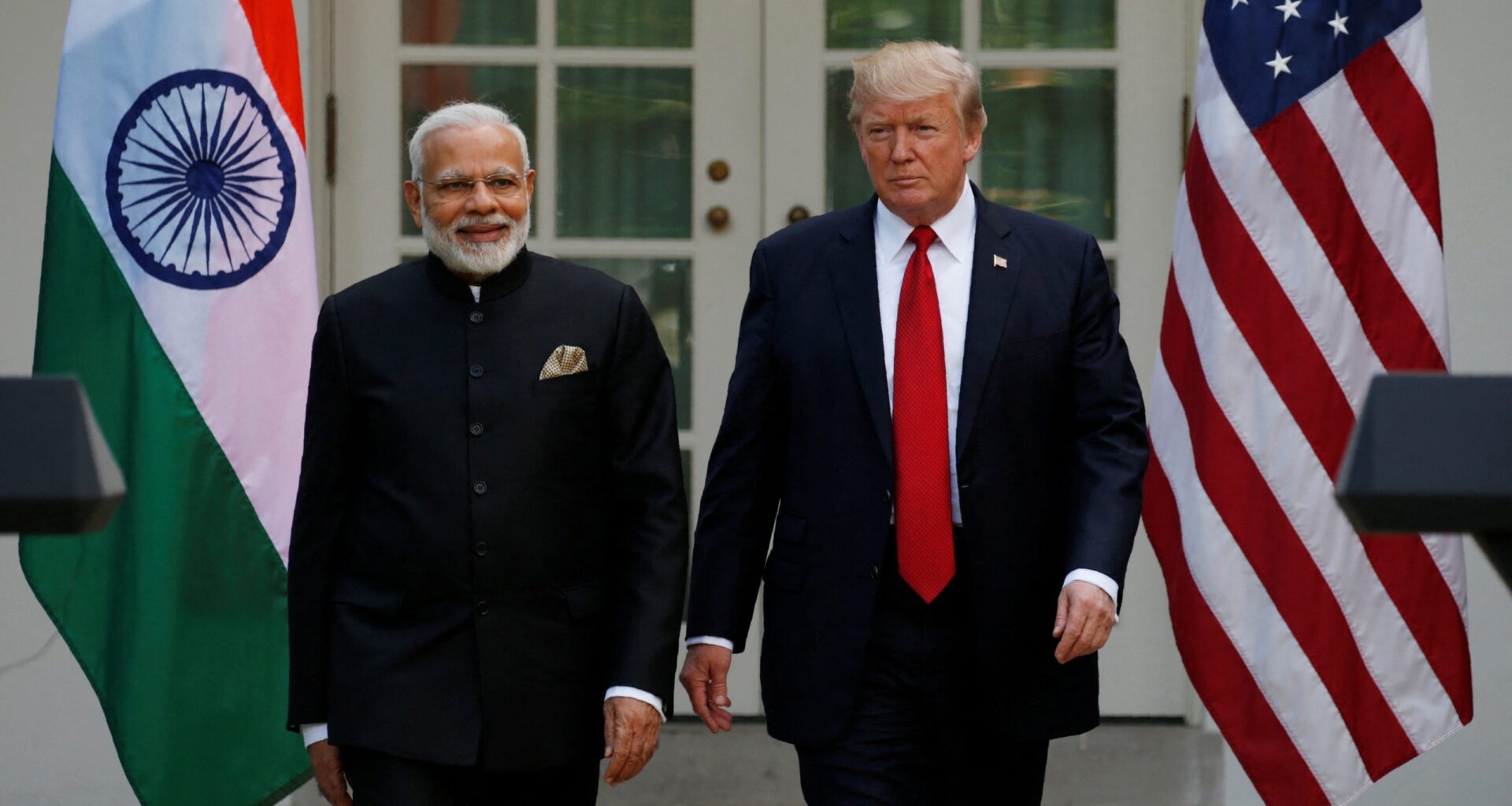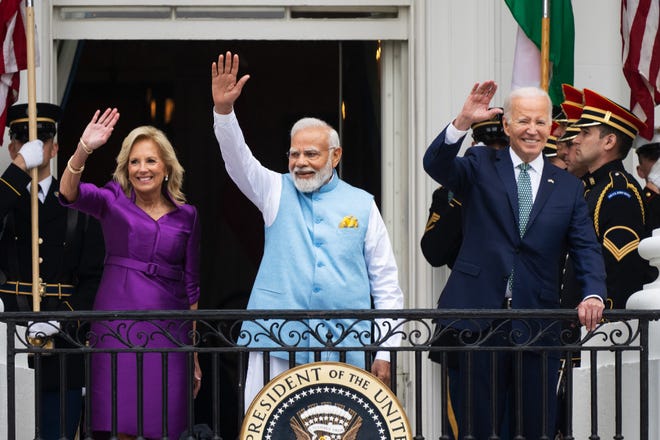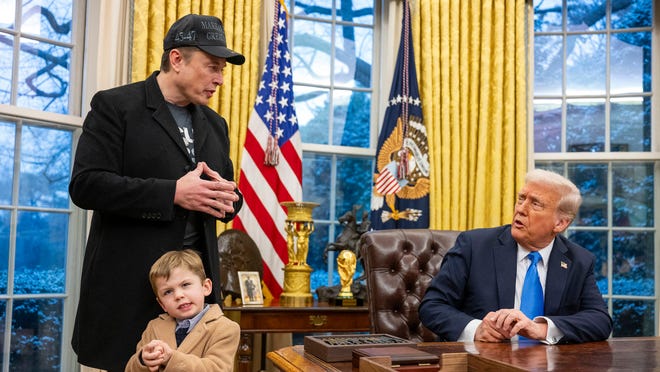WASHINGTON – In a recent interview, President Donald Trump described Indian Prime Minister Narendra Modi as a friend − someone who “looks like he’s your father.”
Then came the ultimate Trump praise.
“He’s the nicest,” Trump said. “Total killer.”
On Thursday, when Modi arrives at the White House, he’ll be among a handful of leaders visiting Trump in the first weeks of his second presidency. The leaders are expected to address the touchy topic of tech-friendly H-1B visas, along with trade and defense.
More:Musk vs. MAGA: Trump supporters battle over role of immigrant labor and American workers
The U.S. has been courting India across administrations as it increasingly sees the South Asian country as a strategic counterweight to China. Former President Joe Biden hosted Modi for a state visit in 2023 and invited him to his home in Delaware in 2024.
Modi will arrive in Washington having met Vice President JD Vance in Paris at the AI Action Summit on Wednesday. Modi had coffee with Vance and Second lady Usha Vance, a daughter of Indian immigrants.
Here are 3 things to know about Modi’s visit:
Immigration and H-1B visas
In December, Trump’s appointees to head the Department of Government Efficiency, billionaire entrepreneurs Elon Musk and Vivek Ramaswamy, ignited a political firestorm when they wrote about the need for foreign workers in technical fields.
Musk, an immigrant from South Africa, wrote on X that there was a “permanent shortage of excellent engineering talent” and that it was limiting Silicon Valley.
The following day, Ramaswamy, whose parents are Indian immigrants, offered an explanation of why that was: American society “venerated mediocrity over excellence,” he wrote.
A swift backlash from Trump’s MAGA world, many of whom oppose immigration, ensued. Trump was forced to weigh in, saying he was a “believer in H-1B,” having hired some workers under the program for his properties. It was a different stance from his first go around as president, before his recent embrace by tech titans.
Companies use the H-1B visa, capped at 65,000 per year, to hire foreign workers in specialty occupations for up to six years. In 2023, 65% of petitions approved were for workers in computer-related occupations. Indian nationals received 72% of approvals in 2023.
During Trump’s first term, the denial rates for H-1B visas skyrocketed to 24% in 2018 compared to 6% in 2015 under former President Barack Obama. The rates came down during the Biden Administration to under 5%.
Stephen Yale-Loehr, an immigration law attorney and a retired Cornell Law School professor, said while Modi can ask Trump to increase the number of H-1B visas, only Congress has the authority to do that.
“More realistically, Modi could ask President Trump not to slow down H-1B processing or issue more requests for additional evidence or denials,” said Yale-Loehr. “There is an internal conflict between some of President Trump’s advisors, like Elon Musk, who like H-1B visas, and others like Steve Bannon who want to restrict H-1B visas.”
Tough tariff talk
During a phone call with Modi after his inauguration, Trump asked the prime minister to move toward a “fair bilateral trading relationship,” according to a White House readout of the call.
Trump called India a very “big tariff abuser” in September and Modi’s visit is expected to include a discussion of a “possible mini trade deal,” according to Reuters.
The U.S. goods trade deficit with India was $45.6 billion in 2024, according to the U.S. Office of Trade Representative.Trump signed an executive order Monday imposing 25% tariffs on all steel and aluminum imports in an ongoing escalation of a trade war with key partners.
Trump also said he would be announcing “reciprocal tariffs” in the coming days. The tariffs would be proportional to the tariffs individual countries place on imported American goods.
In a preemptive move to avoid a trade war like the ones with Canada, Mexico and China, India is weighing tariff cuts in at least a dozen sectors, from electronics to medical and surgical equipment, and chemicals, according to Reuters.
India was the world’s largest arms importer from 2019-2023, accounting for 10% of global major conventional weapons imports. Russia, the largest provider of arms to India, delivers about 36%.
New Delhi is expected to spend at least $200 billion in the coming decade to modernize its armed forces, according to a December report by the Congressional Research Service. In his call with Modi, Trump said he’d like to see India buy more weapons from the U.S.
Howdy Modi – Namaste Trump
During his first meeting with Trump in 2017, Modi enveloped the president, who is known for his awkward power handshakes, in a bear hug. It was the beginning of an unlikely bromance between two populist leaders known for their nationalist ideologies. If Trump is “America First,” then Modi is “Make in India.”
Modi, 74, the first prime minister to be born in independent India, is fond of calling himself a “chaiwala,” or tea seller. The wooden tea stall his family owned and where he worked as a young boy is now a tourist destination in his native state of Gujarat.
After rising through the ranks of the Bhartiya Janata Party, a Hindu nationalist political party, Modi was elected prime minister in 2014.
Modi’s ascent, however, was also clouded by accusations of turning a blind eye to anti-Muslim riots in 2002, which killed more than 1,000 in Gujarat when he was the chief minister of the state. The Indian Supreme Court later cleared him of wrongdoing.
Trump got a firsthand glimpse of Modi’s popularity in 2019 when a Houston rally dubbed “Howdy Modi” organized by the Indian community drew more than 50,000 people. When Trump visited India in 2020, his last oversees trip as president, the trip was christened “Namaste (Howdy, or greetings in Hindi) Trump.”
Swapna Venugopal Ramaswamy is a White House Correspondent for USA TODAY. You can follow her on X @SwapnaVenugopal


